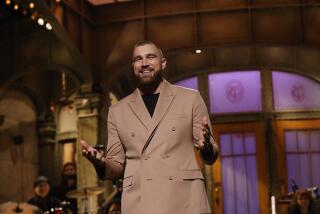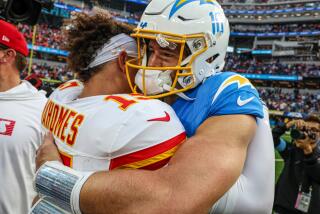IRV EATMAN : Former USFL Star Helps Chiefs Bring Offense Into Line
- Share via
KANSAS CITY, Mo. — For most, football has become a game of statistics.
But one set of players--the offensive linemen--have no statistics. There is no way to look quickly at a set of figures and decide who did the job and who didn’t.
Irv Eatman, the 290-pound offensive tackle of the Kansas City Chiefs, by way of UCLA and the United States Football League, is recognized as one of the best. For three years he was all-USFL with the Philadelphia/Baltimore Stars.
“They don’t set up stat sheets for us, but there’s a couple of ways to find out what’s going on in the offensive line,” Eatman said.
“First, you see how many times the quarterback was sacked. If he got sacked a lot, you’ll probably read about what a great job the other team’s defensive team did. If he didn’t get sacked, somebody might say he got good protection, but more than likely you won’t read about it at all.
“Second, if the stats on the running game and the passing game are about the same--and you won the game--you know the offensive line was doing something right.
“It’s the nature of the job that the offensive line only gets noticed when it allows too many sacks. There are 65 to 70 plays in a game, and if the guy against you makes two sacks, you’ve had a rotten game. I know that’s the way I feel, that if my guy gets two sacks, I could kill the guy.”
Eatman is a major force in an almost all-new offensive line that Coach John Mackovic will field Sunday against the Raiders at sold-out Arrowhead Stadium.
Guard Brad Budde, 271, a former USC All-American, is the elder statesman of the unit, this being his seventh year. Tackle David Lutz, 295, is starting his third season. Guard Mark Adickes, 274, like Eatman, is from the USFL. Center Rick Donnalley, 270, was obtained in an off-season trade, and all-purpose backup Brian Jozwiak, 308, was the Chiefs’ No. 1 draft pick out of West Virginia.
“We are definitely an up-and-coming team,” Eatman said of the Chiefs (3-1). “When we have some more time together, we will be a good offensive line, and to win football games, that’s what you have to have.
“We feel we can make an important impact on the league right now. The team has been in a holding pattern the last couple of years, and with the new components and the development of some of the veterans, we’re on the rise.”
Last season, the Chiefs had the worst rushing attack in the National Football League, averaging only 92 yards in a 6-10 season. In four games this season, they have averaged 127 yards, to go with a 157-yard passing average.
“Balance is what we need, and we’re getting it,” Eatman said.
“The worst thing that can happen to an offensive lineman is to be sitting there, third and 10 or third and 15, and know they’re coming at you. There’s no secret what’s going to happen, and you can see the look in the other guys’ eyes when they see that quarterback only a few feet away. They’re just licking their chops, and you’re the only thing between them, a sack and giving up the football.”
It doesn’t show up in the statistics sheet, but Eatman gives assurance that the rewards are there.
“You hold off the rush, you make the first down, you feel as good as the other guys do when they get the quarterback,” he said. “That’s what the game is all about, really, one guy head to head against another guy, and see who wants it the most.”
Eatman knows how it is to be on the other side, using the great leverage of his 6-foot 7-inch frame to pry an opening in the offensive line and get to the quarterback.
In his sophomore year at UCLA, in only his fourth game as a starter, Eatman made an impact on national television that caused pro scouts to jot his name down in their future book.
Eatman sacked Ohio State quarterback Art Schlichter four times, twice on successive plays, and helped hold the Buckeye All-American to 59 yards of total offense in a 17-0 UCLA win.
“That was a great thrill, something I’ll never forget because it was in my home state and was the first major step in my becoming recognized as a good football player,” he said.
Eatman went to high school in Dayton, Ohio.
In his senior year at UCLA, however, Coach Terry Donahue switched Eatman to the offensive line to help protect quarterback Tom Ramsey. The change proved to be a profitable one for Eatman, for that turned out to be where the pros wanted him to play.
When Eatman completed his eligibility by playing in the 1983 Rose Bowl game on his 22nd birthday, the newly formed USFL was waiting with the war chest that also sidetracked stars such as Herschel Walker, Jim Kelly and Kelvin Bryant away from the NFL.
The Stars offered him a four-year contract worth $1.2 million, and as Eatman said at the time: “Point blank, it was just too good for me to pass up.”
Even though Eatman was signed and already was playing in the USFL when the NFL held its draft, Kansas City took a flyer and selected him on the eighth round.
“At that time, I didn’t pay much attention to it. I thought the USFL would last as long as I played the game. I wanted to see the league succeed, and I expected it would.
“Our team stayed intact for three years and had great success. We won two championships and only missed a third one by two points. I have no regrets in playing with the other league. I had a great time.”
Eatman’s biggest thrill in the USFL was defeating George Allen’s Arizona team, 23-3, in the 1984 championship game at Tampa, Fla.
“That was the high point of my career,” Eatman said. “We won 19 games that season and we had a great bunch of guys on the team.”
Running back Kelvin Bryant and quarterback Chuck Fusina were the players Eatman protected. After the Phoenix win, the coaches gave Eatman the game ball.
“That game was also the high point for the USFL. The league was looking strong after that season. I never dreamed it would end up the way it did.”
Following the 1985 season, when league owners couldn’t decide if they should continue with a spring schedule or battle the NFL in the fall, Eatman and all the USFL players were held in limbo for more than a year until the decision was made to suspend operations.
“Just getting a chance to play this season rates as one of my biggest thrills,” Eatman said. “I was away from football for 13 months waiting for the USFL owners to make up their minds. I didn’t know where my career was going. I just wanted to play, and the longer we stayed away, the worse things seemed.
“It was a real thrill just to sit down and sign a contract with the Chiefs and know I was going to play again.”
It was also lucrative. Sources say Eatman will receive $1.6 million over four years. This includes a $425,000 bonus for signing, plus a base salary of $250,000 this season, $275,000 in 1987, $300,000 in 1988 and $350,000 in 1989.
Eatman enjoys Kansas City because it is a new place for him to browse around.
“I enjoy living in different places in the country,” he said. “That’s the only way you can get a real grasp about the way people live. Some people stay in one place all their life and watch TV to see how other folks live, but they get a false picture. I want to be there, to absorb the different climates and cultures.”
Eatman spent his early years with his mother in Birmingham, Ala., then moved to Dayton when he was 15 to live with his uncle, in hopes of getting a scholarship so he could go to California and play football at UCLA.
“I had always wanted to go to UCLA since I was a little kid watching USC-UCLA games on TV,” he said. “UCLA was always the underdog in those days, and I liked that. I wanted to see what California was really like, and going to UCLA fit right in. I guess it was the mystique of California that attracted me.”
So now, after living in Alabama and Ohio, going to college in California and playing professionally in Philadelphia, Maryland and Missouri, where does Eatman live?
Tampa.
“We played the championship game in Tampa in 1984, and I really liked it,” he said. “After the 1985 season, I took off for Tampa and lived there. I guess I’d call it home, but I never stay in any one place too long.”
More to Read
Go beyond the scoreboard
Get the latest on L.A.'s teams in the daily Sports Report newsletter.
You may occasionally receive promotional content from the Los Angeles Times.










